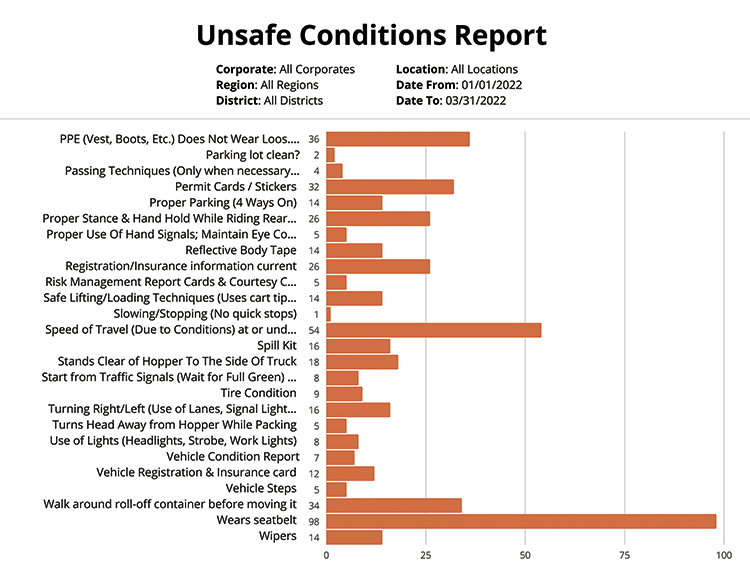In today’s safety culture, everyone wears more than one hat. With an online compliance system, clients gain access to analytics that help them pinpoint high risk areas in their daily operations, which enable them to be more proactive, rather than reactive, with their safety.
By Caroline Sharpless
Safety programs fall short when companies spend all their time playing catch-up. Getting and staying ahead of the game is often easier said than done, especially when safety departments are understaffed and in charge of managing multiple locations. When safety managers are busy responding to accidents and fines, little time is left to build prevention initiatives.
Without fluid communication, thorough training, and comprehensive processes, it is also difficult for employees, such as drivers or field workers, to understand how to approach safety and compliance issues. Modern safety issues require a modern solution: digitizing compliance.
Implementing a comprehensive digital solution can lead to improvements in internal company efficiency, as well as external reporting to regulatory agencies.
Going digital significantly reduces reporting time and helps management identify redundancies, common mistakes, and problematic practices. As many as 80 percent of organizations that switched to digital reporting increased profits, according to a 2017 SAP report (www.sap.com/index.html).
In today’s safety culture, everyone wears more than one hat. With an online compliance system, clients gain access to analytics that help them pinpoint high risk areas in their daily operations, which enable them to be more proactive, rather than reactive, with their safety. The effectiveness of a “one-stop shop” for safety, compliance, and training shows itself in clients’ decrease in incidents, with the added benefit of showing employees that safety matters to the company.1
Discover Costly Inefficiencies and “Dangerous Oversights
Forty percent of all occupational fatalities in 2019 were attributed to transportation incidents, according to the Bureau of Labor Statistics. Though some motor vehicle accidents are unpreventable, there are still measures employers can take to ensure vehicles are running properly and drivers are following all the necessary precautions. Thorough pre- and post-trip Driver Vehicle Inspection Reports (DVIRs) are one of the most effective ways to accomplish this.
In the U.S., the Federal Motor Carrier Safety Administration (FMCSA) requires the completion of a driver vehicle inspection report specified under Federal Law 49 CFR 396.11 and 396.13 to ensure commercial motor vehicle and road safety and compliance. Violating the DVIR requirements could result in hefty fines. Civil penalties run up to $1,270 a day for failing to complete a DVIR, $12,695 for knowingly falsifying, destroying, or changing DVIR records, and $15,419 for each non-recordkeeping violation. Further, DOT officers will immediately put trucks out of commission if they are deemed unsafe. This can result in significant productivity and revenue loss.

Images courtesy of Safety Management Systems.
Mobile DVIR applications allow drivers to quickly complete their DVIR on their smartphone or tablet by checking a series of boxes and clicking from drop-down menus. An excellent online DVIR system goes a step further and automatically sends e-mail updates to maintenance departments and supervisors. A great system will also update in real-time, allowing people in the office to see updated information as it is entered from the field. This eliminates steps in the communication chain and helps ensure everyone is adequately informed.
With a digital DVIR system, supervisors can quickly find out why vehicles are being put out of service and for how long—without the drivers or maintenance department needing to take any extra steps to contact them. Management can also use DVIR reports to identify which defects are occurring most frequently and take the necessary measures to prevent them from occurring in the future. This real-time oversight also makes it easier for supervisors to identify which drivers are not completing their DVIRs accurately. Improvements in vehicle lifespans, driver efficiency, and overall communication can be achieved in far less time than the typical paper-based checklists.
During an audit or inspection, companies could present years’ worth of DVIRs in seconds, if asked, by filtering or searching DVIRs by date and location.
Never Miss a Permit Expiration Date Again
Are your permits up-to-date? Do you know where your permits are? Are your permits’ required tasks getting completed? If not, you could be shut down at a surprise inspection. Housing permits in an online Regulatory Compliance portal allows you to access all of your regulatory documents with the click of a button. This way, you will not need to worry when a surprise inspection or client audit comes your way. Search permits by location, name, date, etc., and find permits in seconds instead of digging through paper files. A cloud-based system allows you to access files from any computer via login instead of being confined to a single office desktop computer.
The ideal regulatory compliance solution not only houses permit files and permit information, but also keeps track of violation notices, permit tasks, inspection history, and permit expiration dates. Automated e-mail reminders let you know when a permit is nearing expiration, so you do not have to manually check the dates yourself or worse—forget to renew them. Safety tasks pile up and more often than not, small clerical tasks like keeping track of permits get pushed to the bottom of the to-do list. Required permit tasks also often get left behind. A good regulatory compliance system will allow you to set auto-reminders to ensure employees do not forget to complete them.

Avoid Fines by Automating Your OSHA and DOT Compliance
In most cases, the OSHA 300 log is the first document OSHA will ask for in an inspection. Failure to maintain OSHA records can result in penalties of up to $14,502 for each year of the violation, as of January 2022. A digital compliance system can pull your data into an OSHA formatted, ready-to-submit document. Forms like the OSHA 300, 300A, or 301 need to be posted onsite for employees to see.
The 301 incident reports need to be promptly completed and submitted within seven days of the accident. Using a mobile-friendly system allows employees to upload photos and complete necessary questions right from the scene of the accident. Drop-down menus and pre-filled information make the process quicker and simpler than paper forms.
The OSHA 300-A form, due once a year, compiles the data from the other OSHA forms. Rather than sorting through paper files, and trying to pull everything together, this can be generated in a single click. Housing these documents online also makes it easier to comply with OSHA’s requirement that these forms be made available to workers when they ask to see them.
Ensure Compliance by Taking Your Safety Data Sheets Binder Digital
The key to protecting employees from hazardous chemicals used or stored in the work environment is having Safety Data Sheets (SDS) accessible instantly. This way, when a spill or incident occurs, the employees involved can quickly receive accurate first aid guidance. Products are constantly changing, as are their safety and first aid recommendations. Because of this, OSHA requires SDS to be updated every three years, and old SDS must be kept for 30 years. When looking for an SDS management tool, be sure to find one that automatically updates SDSs for you. This eliminates the to need to have an employee spend time checking SDS expiration dates and chasing down new SDS suppliers.
Also, referred to as Right to Know, the OSHA Hazard Communication Standard (HCS) requires that training and information be provided to any employees who have the potential of being exposed to a hazardous chemical “under normal condition of use or in a foreseeable emergency.”
The SDS includes information about the properties of each chemical, the physical, health, and environmental health hazards, protective measures, and all safety precautions for handling, storing, and transporting the chemical. Employees are required to have immediate access to the information without leaving their work area. These violations cost U.S. firms millions of dollars every year.
The recent study, “Tech Roadmap EHS Technologies 2022,” conducted by independent research firm, Verdantix, found that SDS management platforms are of high business value to companies.
“Access to safety data sheets (SDSs) forms a core component of firms’ compliance efforts,” Verdantix analyst Chris Sayers said. “At Verdantix, we are seeing a drive towards software functionality to streamline access to applicable SDS.”
An online solution is the only sure-fire way to ensure the most recent, updated information is being obtained. Companies can access and add SDS instantly, across multiple locations, straight from computers or mobile devices.
Pinpoint High-Risk Areas
While many companies conduct some form of regular internal safety observations checks, they are not receiving that maximum number of benefits if they are not using a digital system. Safety managers gain the ability to access reports that display key insights from the data inputted in daily or weekly observations checks.
As seen in Figure 1, this report shows the safety manager that there were 98 instances of drivers not wearing seatbelts and 36 instances of incorrect PPE usage. Based on this observation, safety managers can implement new incentives or restrictions to ensure drivers change their behavior.

A sample report compiled from daily safety observations. Based on this data, safety managers can create new incentives or restrictions to ensure improvements onsite.
These reports can show everything from safe lifting and loading techniques to vehicle health to facility fitness. Customizable observation checklists can be applied to your landfill inspections, hauling inspections, vehicle inspections, facility inspections, and route inspections.
Technology companies see the pains waste companies face daily and have created digital solutions to maximize time, efficiency, and cost, while also making it easier to protect employees. Sometimes change seems daunting, but it is inevitable. Do not keep postponing your company’s success by ignoring the digital solutions available to you. | WA
Caroline Sharpless is Director of Marketing for Safety Management Systems, Inc., whose product. SMS360, is an all-in-one online software (SaaS) that allows companies of any size to increase revenue by streamlining compliance and risk management programs. From a computer, tablet, or mobile device, safety managers can pinpoint high-risk areas to predict and prevent accidents, save significant time on regulatory reporting, while reducing OSHA, DOT, and other regulatory fines. For more information, visit www.sms360.com or https://calendly.com/sms360-mike/sms360-consultation to schedule a free consultation and demo.
Note
1. Safety Management Systems, Inc. VP of Client Relations, Mary Dunlap.
